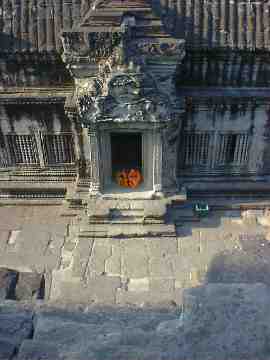|
Finally, we arrived at Angkor Wat itself. We had driven past it a number of times in the short time we'd been in
Siem Reap, each time increasing my anticipation of actually going there. Angkor Wat is just awesome. You can see
all the pictures you want, but none of them capture the majesty of it. The size of the wat, and the precision in its
symmetry, are breathtaking. At this point of the trip, we were all running out of adjectives. We'd used "amazing"
and "incredible" and "unbelievable" so many times, and for so many different things, that we were starting to get tired of
saying them.
The workmanship that went into Angkor Wat is amazing. The precision and symmetry of its layout are so perfect that
even my architecturally untrained eye couldn't miss it. And then there's the sheer size of it. It's huge, absolutely
immense, but without any feeling of oppressiveness. A long, wide stone walkway from the main gate in the outer wall
to the temple itself gives you plenty of time to appreciate the way the temple slowly grows in your vision, becoming more
and more impressive as you approach. The detail work is no less impressive. High in the upper reaches of the temple,
you catch glimpses of the intricately carved edges of bas-reliefs placed where they would likely never be seen by anyone one
but the artist who carved them. It's hard to believe that so much of the detail of the carvings survived centuries in
the jungle.
There is plenty to see in the galleries at ground level, but to get to the heart of the temple you have to climb a very
high, very steep staircase. This, after a long day of scrambling up and down vertigo-inspiring stairs, was almost more
than my legs could handle. But I slipped into the slow-moving line of tourists clutching at the flimsy iron railing
and creeping carefully up the stairs. Some of the braver monks and backpackers scrambled up and down the unrailed corner
staircases, which was hair-raising to watch, but really probably no more dangerous than joining the crowds on the main staircases.
Any one who lost their footing in the crowd would've taken out most of the people below them on their way down.
Angkor Wat is peppered with niches where Buddhas reside, draped in orange cloth and surrounded by offerings - fruit,
food, money, branches of gold-foil leaves, and the ubiquitous heavy scent of pungent cheap incense. Most of the shrines
are tended by old men or women with close-cropped hair who wave incense at the tourists, entreating them to kneel and burn
incense before the Buddha. They kneel with you and chant prayers when you comply. I didn't see anyone young tending
a shrine, and I never did find out whether tending the shrine is a customary job of the old, a reward for living a long and
exemplary life, a penance, or what.
Another common, and much sadder, sight at every tourist site in Cambodia are the beggars, most of whom are amputees.
The civil war between the government and the Khmer Rouge, and unexploded ordinance from the US bombing of Cambodia during
the Vietnam War have made life in Cambodia a very risky business for people who live near forests or work in the fields.
Conservative estimates say that de-mining efforts in Cambodia will continue for decades. All the guidebooks warn tourists
against straying from the paths around Angkor, due to the danger of landmines.

|
| These monks took a picture of me, so I took a picture back |
|